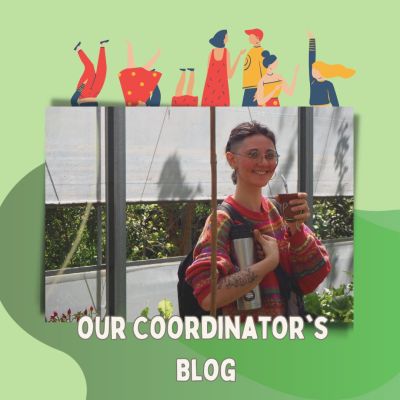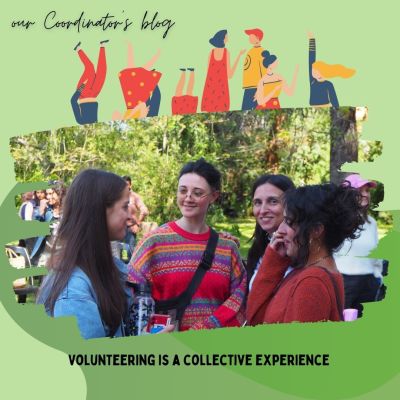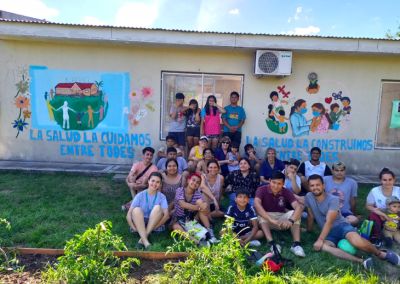by Stine Albrechtsen Purple trees, exotic smells, tango shows, big steaks and magnificent wine.
I heard nothing but good things about this city before I arrived, so, as one might guess, my expectations were set high. I left cold and grey Denmark in the middle of November, the first month of the hard and dark winters we have in Northern Europe. I always wanted to experience Buenos Aires, and if you ask why, I have no answer. It came to me a couple years ago, maybe I heard some Argentinian music, heard a travel story or saw something on the news. Anyways now I am here, not regretting my decision. Buenos Aires is a strange city. It is slow and fast going at the same time. It is ugly with an unquestionable beauty. It is extremely friendly and your worst enemy. It is everything, taking care of the good and the bad. Restaurants and cafes on every corner, tons of cultural wonders and events, pollution, trash, gigantic boulevards with non-stopping honking, majestic mansions three minutes from the shanty towns, pocket thief’s, street theatre and always this breathtaking history. Like all big cities or capitals. Could I just as well be in Rio, Barcelona or even Hong Kong? No. Who am I kidding; this city is one of a kind. I was given an assignment to write about Buenos Aires from a “25-something-girl-from-a-small-town-in-Denmark-Scandinavia” point of view. I guess it is no fun to write about the things that have made me cry, so my approach will be to write about the things that made me fall in love. And that will work, because I am completely and without any doubt head over heels with the big and beautiful BA. I do not know the best way to explore the city. My way to do it is a combination of personal wishes, recommendations from guidebooks, travel blogs or the local porteños, spontaneous ideas and then, most important, or I just go with the flow. I am no expert; I only have been here for something that feels like 20 minutes or forever. Actual time: 3 weeks. Let us begin. …How to meet new people  Well that is actually very easy: go to a cemetery. Odd? At my second day in the city I went to Cementorio de la Recoleta, you know, the place where Eva Perón lies buried. Did you know her body was stolen by the way? It was - for nearly 20 years. Only three years after the whole country buried their true queen, angry anti- Perón forces stole Eva’s remains in the wake of a coup that deposed her husband, President Juan Perón. The body of the beloved Evita became a global odyssey, traveled across the world in the wrongs hands, including a new burial in Milan. Almost 20 years went by before Eva, the saint of Argentina, was back in the arms of a country, who had been craving her present and strength for the past 20 years of violence and chaos. This woman had reached a saint status, despite her early death in 1952, at the age of 33 she lost the battle to cancer. Her husband remarried again in 1961 to Isabel Martinez – an exotic dancer who he met during his exile in Panama. To add a little extra twist to the story of the Perón family, Isabel actually became the president of Argentina after the loss of her husband in 1974. From exotic dancer to being president of eighth largest country in the world - that is some career advancement! Well, back to my original purpose: the cemetery of Recoleta is an extremely beautiful place to visit. Both inside among the great tombs and outside under the shades of the purple trees. The sight inside has a formally mood, while the outside area is brimming with life: the locals are gossiping the latest news of the neighborhood while drinking mate and smoking cigarettes. Tourists are writing postcards and eating colorful ice-creams from one the three famous helado shops surrounding the park (try one!). There are young backpackers on the grass drinking wine and playing guitar. And that beautiful young Argentinian girl longing for a lullaby. Go here. You will definitely meet someone: a new friend, a travel buddy, a pickpocket or maybe even your soul mate. I met an American couple in their late sixties on their last week of a three month trip across South America. I shared beers with them the following day. …How to learn the language If you think you are rock star with Spanish, change your beliefs. The Argentinians are like their capital when it comes to the Spanish language: unique, too fast and nothing like you have ever experienced before. So here is an extra challenge on top of the 240 others you will be faced during you stay here. But I want to learn. Every time I get the opportunity to speak to a local, I try. If I am lucky, they understand fragments. Maybe they understand just as much as Isabel understood her country and its people. Fragments. As one might know, the weather in Buenos Aires can be extremely sweat provoked during December and January. I have found a little oasis where I can actually manage to stay alive during the hot hours of the day: Plaza General San Martin. I like to go there with my (at the moment) favorite book, ‘And the Mountains Echoed’, a cold soda and a fruit box from the local kiosko. One day when I was in the middle of the fourth chapter, an older woman with her 7 month old grandson joined me on the bench. We introduced each other, her name was Laura. I asked for recommendations for good restaurants, but instead of a proper answer I got a story: the story of San Martin, the war hero whose name laid the foundation to this nice park. The good Jose Francisco de San Martin is, according to Laura’s utterances, the true liberator of South America. The general was the prime leader of the southern part of South America's successful struggle for independence from the Spanish Empire. Well, thank you Jose! He was born in Corrientes, but moved to Malaga at the age of seven to study. In the year of 1812 (or something like that, Laura was not fully sure) he set sail for Buenos Aires and became buddies with the supporters for independence from Spain. It seems they got along very well, because they even managed to establish their own army; The Army of the Andes. After crossing the Andes on a mule (and noton a great white horse as the majestic statue in the middle of the parks tells) he and his friends freed Chile and Peru. Laura was just about to tell me the rest of the story when her grandson started crying. She had to leave, and kiss-kiss-chao she was gone. But I sure learned a lot of the Argentinian “language” that wonderful hour in the park of General San Martin. By the way: The Order of the Liberator General San Martin is the highest decoration one can receive by the Argentine government. I read that when I got home that day, curious by Laura’s story. When I have more time I need to find out what happened to this handsome war hero.
Well that is actually very easy: go to a cemetery. Odd? At my second day in the city I went to Cementorio de la Recoleta, you know, the place where Eva Perón lies buried. Did you know her body was stolen by the way? It was - for nearly 20 years. Only three years after the whole country buried their true queen, angry anti- Perón forces stole Eva’s remains in the wake of a coup that deposed her husband, President Juan Perón. The body of the beloved Evita became a global odyssey, traveled across the world in the wrongs hands, including a new burial in Milan. Almost 20 years went by before Eva, the saint of Argentina, was back in the arms of a country, who had been craving her present and strength for the past 20 years of violence and chaos. This woman had reached a saint status, despite her early death in 1952, at the age of 33 she lost the battle to cancer. Her husband remarried again in 1961 to Isabel Martinez – an exotic dancer who he met during his exile in Panama. To add a little extra twist to the story of the Perón family, Isabel actually became the president of Argentina after the loss of her husband in 1974. From exotic dancer to being president of eighth largest country in the world - that is some career advancement! Well, back to my original purpose: the cemetery of Recoleta is an extremely beautiful place to visit. Both inside among the great tombs and outside under the shades of the purple trees. The sight inside has a formally mood, while the outside area is brimming with life: the locals are gossiping the latest news of the neighborhood while drinking mate and smoking cigarettes. Tourists are writing postcards and eating colorful ice-creams from one the three famous helado shops surrounding the park (try one!). There are young backpackers on the grass drinking wine and playing guitar. And that beautiful young Argentinian girl longing for a lullaby. Go here. You will definitely meet someone: a new friend, a travel buddy, a pickpocket or maybe even your soul mate. I met an American couple in their late sixties on their last week of a three month trip across South America. I shared beers with them the following day. …How to learn the language If you think you are rock star with Spanish, change your beliefs. The Argentinians are like their capital when it comes to the Spanish language: unique, too fast and nothing like you have ever experienced before. So here is an extra challenge on top of the 240 others you will be faced during you stay here. But I want to learn. Every time I get the opportunity to speak to a local, I try. If I am lucky, they understand fragments. Maybe they understand just as much as Isabel understood her country and its people. Fragments. As one might know, the weather in Buenos Aires can be extremely sweat provoked during December and January. I have found a little oasis where I can actually manage to stay alive during the hot hours of the day: Plaza General San Martin. I like to go there with my (at the moment) favorite book, ‘And the Mountains Echoed’, a cold soda and a fruit box from the local kiosko. One day when I was in the middle of the fourth chapter, an older woman with her 7 month old grandson joined me on the bench. We introduced each other, her name was Laura. I asked for recommendations for good restaurants, but instead of a proper answer I got a story: the story of San Martin, the war hero whose name laid the foundation to this nice park. The good Jose Francisco de San Martin is, according to Laura’s utterances, the true liberator of South America. The general was the prime leader of the southern part of South America's successful struggle for independence from the Spanish Empire. Well, thank you Jose! He was born in Corrientes, but moved to Malaga at the age of seven to study. In the year of 1812 (or something like that, Laura was not fully sure) he set sail for Buenos Aires and became buddies with the supporters for independence from Spain. It seems they got along very well, because they even managed to establish their own army; The Army of the Andes. After crossing the Andes on a mule (and noton a great white horse as the majestic statue in the middle of the parks tells) he and his friends freed Chile and Peru. Laura was just about to tell me the rest of the story when her grandson started crying. She had to leave, and kiss-kiss-chao she was gone. But I sure learned a lot of the Argentinian “language” that wonderful hour in the park of General San Martin. By the way: The Order of the Liberator General San Martin is the highest decoration one can receive by the Argentine government. I read that when I got home that day, curious by Laura’s story. When I have more time I need to find out what happened to this handsome war hero.
So to sum up: if you want to learn the language, take a couple of hours out of your day and find a bench in a nice park. If a porteño (well, that is the name of the people of Buenos Aires) does not join you in 10 minutes or so, find one and ask for restaurant recommendation. …How to treat your taste buds Note: if you are a vegetarian just jump to the next chapter, I am sorry but you will not find anything useful here. Or maybe you will, I guess it depends - if you like street art and artsy areas you can keep on going. The area is called Heaven on Earth by the author of my travel book. He lingers on with flattering words like trendsetting, a perfect get-away and magnificent. Palermo is the barrio of great restaurants, hip nightlife, local cafes and famous street art located north-west of the city centre. Of course I had to go there day one. And yes: I entered heaven on earth. It was the first real summer evening, so the girls of Buenos Aires wore their new summer dresses for the first time. So did I. As I wrote in the beginning of this article it is all about falling in love with the beautiful BA. As for me, I met my loved one in a Palermo restaurant close to midnight. BOOM! As a warm breeze hit my face I saw him for the first time. He was the most perfect thing, I have ever seen. Tender, delicious and finger licking hot. He was something; he was a Bife de Chorizo. I know it sounds crazy but when you literally want to make love to a piece of steak, you know you have entered heaven on earth. Such a shame I was in a public restaurant. Go to Palermo and fall in love. Maybe not with an actually human being (maybe?), but definitely with the Argentinian food culture. That is certainly a way to kick your taste buds to the moon and back.  With the touch of my new love fresh in my memory I walked around Palermo. This barrio is divided into a couple of sub-areas: Palermo Chico, Palermo Viejo, Palermo Soho and Palermo Hollywood. One more trendy and more fantastic than the other. Just walking around cozy cafés, beautiful parks, fancy shops, local galleries - all covered with amazing, colorful and provocative street art. You constantly want to sit down in a café, on the pavement, whatever, just to take in the atmosphere of this area. Luckily there are many places to do so. And if you feel that you haven’t treated your taste buds enough: Go to Soria Bar in Palermo Hollywood and taste their mojitos!
With the touch of my new love fresh in my memory I walked around Palermo. This barrio is divided into a couple of sub-areas: Palermo Chico, Palermo Viejo, Palermo Soho and Palermo Hollywood. One more trendy and more fantastic than the other. Just walking around cozy cafés, beautiful parks, fancy shops, local galleries - all covered with amazing, colorful and provocative street art. You constantly want to sit down in a café, on the pavement, whatever, just to take in the atmosphere of this area. Luckily there are many places to do so. And if you feel that you haven’t treated your taste buds enough: Go to Soria Bar in Palermo Hollywood and taste their mojitos!
 I could keep and keep on writing about this concrete wonder. I always love to write about feelings, so I think I will end this article doing so. Expect to be touched by different, and sometimes completely conflicting, feelings during your time here. It is a love and hate relationship, an emotional roller-coaster. One moment you feel on top of the world, the next moment ready to leave this confusing car crash jungle overcrowded with freaks. Happiness and sadness are two feelings living as close neighbors in your heart, and an experience, a memory, is a car crash of different feelings. If you want to experience, expect to feel. In this city you feel a thousand different things during one day. And feel lucky for that. Because that brings you three times as many memories.
I could keep and keep on writing about this concrete wonder. I always love to write about feelings, so I think I will end this article doing so. Expect to be touched by different, and sometimes completely conflicting, feelings during your time here. It is a love and hate relationship, an emotional roller-coaster. One moment you feel on top of the world, the next moment ready to leave this confusing car crash jungle overcrowded with freaks. Happiness and sadness are two feelings living as close neighbors in your heart, and an experience, a memory, is a car crash of different feelings. If you want to experience, expect to feel. In this city you feel a thousand different things during one day. And feel lucky for that. Because that brings you three times as many memories.
...By the way, I no longer doubt why they call this city Buenos Aires – the winds are actually what gets you through the day.






